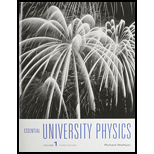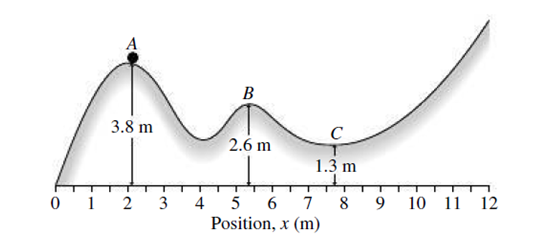
Essential University Physics (3rd Edition)
3rd Edition
ISBN: 9780134202709
Author: Richard Wolfson
Publisher: PEARSON
expand_more
expand_more
format_list_bulleted
Textbook Question
Chapter 7, Problem 26E
A particle slides along the frictionless track shown in Fig. 7.16, starting at rest from point A. Find (a) its speed at B, (b) its speed at C, and (c) the approximate location of its right-hand turning point.

FIGURE 7.16 Exercise 26
Expert Solution & Answer
Want to see the full answer?
Check out a sample textbook solution
Students have asked these similar questions
Is work function of a metals surface related to surface energy and surface tension? What is the need to the work function component in the math of tension of metal surfaces that cannot be provided by existing equations of surface energy and surface tension? What are the key differences in each parameter and variables that allow for a differentiation of each function? What has a more significant meaning work function, surface tension or surface energy? Are there real differences and meaning? Please clarify and if possible provide examples . Does surface tension dependant on thickness of a metal or type of metal surface all having the same thickness? Clearly temperature has a profound change on surface tension what other variables besides temperature are key to surface tension. What if any is there a connection between crystal structure of the element and surface energy and tension? This is NOT a Assignment Question!!!
The cylindrical beam of a 12.7-mW laser is 0.920 cm in diameter. What is the rms value of the electric field?
V/m
Consider a rubber rod that has been rubbed with fur to give the rod a net negative charge, and a glass rod that has been rubbed with silk to give it a net positive charge. After being charged by contact by the fur and silk...?
a. Both rods have less mass
b. the rubber rod has more mass and the glass rod has less mass
c. both rods have more mass
d. the masses of both rods are unchanged
e. the rubber rod has less mass and the glass rod has mroe mass
Chapter 7 Solutions
Essential University Physics (3rd Edition)
Ch. 7.1 - Suppose it takes the same amount of work to push a...Ch. 7.2 - Gravitational force actually decreases with...Ch. 7.3 - A bowling ball is tied to the end of a long rope...Ch. 7.4 - For which of the following systems is (1)...Ch. 7.5 - A bowling ball is tied to the end of a long rope...Ch. 7.6 - The figure shows the potential energy associated...Ch. 7 - Figure 7.14 shows force vectors at different...Ch. 7 - Is the conservation-of-mechanical-energy principle...Ch. 7 - Why cant we define a potential energy associated...Ch. 7 - Can potential energy be negative? Can kinetic...
Ch. 7 - If the potential energy is zero at a given point,...Ch. 7 - If the difference in potential energy between two...Ch. 7 - If the difference in potential energy between two...Ch. 7 - A tightrope walker follows an essentially...Ch. 7 - If conservation of energy is a law of nature, why...Ch. 7 - Determine the work you would have to do to move a...Ch. 7 - Now lake Fig. 7.15 lo lie in a vertical plane, and...Ch. 7 - Rework Example 7.1, now taking the zero of...Ch. 7 - Find the potential energy associated with a 70-kg...Ch. 7 - You fly from Bostons Logan Airport, at sea level,...Ch. 7 - The potential energy associated with a 60-kg hiker...Ch. 7 - How much energy can be stored in a spring with k =...Ch. 7 - How far would you have to stretch a spring with k...Ch. 7 - A biophysicist grabs the ends of a DNA strand with...Ch. 7 - A skier starts down a frictionless 32 slope. After...Ch. 7 - A 10,000-kg Navy jet lands on an aircraft carrier...Ch. 7 - A 120-g arrow is shot vertically from a bow whose...Ch. 7 - In a railroad yard, a 35,000-kg boxcar moving at...Ch. 7 - You work for a toy company, and youre designing a...Ch. 7 - A 54-kg ice skater pushes off the wall of the...Ch. 7 - Prob. 25ECh. 7 - A particle slides along the frictionless track...Ch. 7 - A particle slides back and forth on a frictionless...Ch. 7 - A particle is trapped in a potential well...Ch. 7 - The reservoir at Northfield Mountain Pumped...Ch. 7 - The force in Fig. 7.14a is given by Fa=FoJ, where...Ch. 7 - A 1.50-kg brick measures 20.0 cm 8.00 cm 5.50...Ch. 7 - A carbon monoxide molecule can be modeled as a...Ch. 7 - A more accurate expression for the force law of...Ch. 7 - For small stretches, the Achilles tendon can be...Ch. 7 - The force exerted by an unusual spring when its...Ch. 7 - The force on a particle is given by F=Al/x2, where...Ch. 7 - A particle moves along the x-axis under the...Ch. 7 - As a highway engineer, youre asked to design a...Ch. 7 - A spring of constant k, compressed a distance x,...Ch. 7 - A child is on a swing whose 3.2-m-long chains make...Ch. 7 - With x x0 = h and a = g, Equation 2.11 gives the...Ch. 7 - The nuchal ligament is a cord-like structure that...Ch. 7 - A 200-g block slides back and forth on a...Ch. 7 - Automotive standards call for bumpers that sustain...Ch. 7 - A block slides on the frictionless loop-the-loop...Ch. 7 - The maximum speed of the pendulum bob in a...Ch. 7 - A mass m is dropped from height h above the top of...Ch. 7 - A particle with total energy 3.5 J is trapped in a...Ch. 7 - (a) Derive an expression for the potential energy...Ch. 7 - In ionic solids such as NaCl (salt), the potential...Ch. 7 - Repeat Exercise 19 for the case when the...Ch. 7 - As an energy-efficiency consultant, youre asked to...Ch. 7 - A spring of constant k = 340 N/m is used to launch...Ch. 7 - A bug slides back and forth in a bowl 15 cm deep,...Ch. 7 - A 190-g block is launched by compressing a spring...Ch. 7 - A block slides down a frictionless incline that...Ch. 7 - An 840-kg roller-coaster car is launched from a...Ch. 7 - A particle slides back and forth in a frictionless...Ch. 7 - A child sleds down a frictionless hill whose...Ch. 7 - A bug lands on top of the frictionless, spherical...Ch. 7 - A particle of mass m is subject to a force...Ch. 7 - A block of weight 4.5 N is launched up a 30...Ch. 7 - Your engineering department is asked to evaluate...Ch. 7 - Your roommate is writing a science fiction novel...Ch. 7 - You have a summer job at your universitys zoology...Ch. 7 - Biomechanical engineers developing artificial...Ch. 7 - Blocks with different masses are pushed against a...Ch. 7 - Nuclear fusion is the process that powers the Sun....Ch. 7 - Nuclear fusion is the process that powers the Sun....Ch. 7 - Nuclear fusion is the process that powers the Sun....Ch. 7 - Nuclear fusion is the process that powers the Sun....
Additional Science Textbook Solutions
Find more solutions based on key concepts
Flask A contains yeast cells in glucose-minimal salts broth incubated at 30C with aeration. Flask B contains ye...
Microbiology: An Introduction
Define and discuss these terms: (a) synapsis, (b) bivalents, (c) chiasmata, (d) crossing over, (e) chromomeres,...
Concepts of Genetics (12th Edition)
What type of unconformity separates layer G from layer F?
Applications and Investigations in Earth Science (9th Edition)
4. Three groups of nonvascular plants are _______, ______, and _______. Three groups of seedless vascular plant...
Biology: Life on Earth (11th Edition)
Look at the relative positions of each pair of atoms listed here in the periodic table. How many core electrons...
Organic Chemistry (8th Edition)
Which of the following has the greatest effect on the rate of chemical cycling in an ecosystem? (A) the rate of...
Campbell Biology (11th Edition)
Knowledge Booster
Learn more about
Need a deep-dive on the concept behind this application? Look no further. Learn more about this topic, physics and related others by exploring similar questions and additional content below.Similar questions
- 8. With the aid of a diagram draw the following electric circuit and use the resistor as the load, (a) Closed circuit (b) Open circuitarrow_forwardLab 8 Part 3 PHET Wave Interface simulation. I am having trouble with this part of the lab.arrow_forwardMick and Rick are twins born on Earth in the year 2175. Rick grows up to be an Earth-bound robotics technician while Mick becomes an intergalactic astronaut. Mick leaves the Earth on his first space mission in the year 2200 and travels, according to his clock, for 10 years at a speed of 0.75c. Unfortunately, at this point in his journey, the structure of his ship undergoes mechanical breakdown and the ship explodes. How old is Rick when his brother dies?arrow_forward
arrow_back_ios
SEE MORE QUESTIONS
arrow_forward_ios
Recommended textbooks for you
 University Physics Volume 1PhysicsISBN:9781938168277Author:William Moebs, Samuel J. Ling, Jeff SannyPublisher:OpenStax - Rice University
University Physics Volume 1PhysicsISBN:9781938168277Author:William Moebs, Samuel J. Ling, Jeff SannyPublisher:OpenStax - Rice University Principles of Physics: A Calculus-Based TextPhysicsISBN:9781133104261Author:Raymond A. Serway, John W. JewettPublisher:Cengage Learning
Principles of Physics: A Calculus-Based TextPhysicsISBN:9781133104261Author:Raymond A. Serway, John W. JewettPublisher:Cengage Learning Glencoe Physics: Principles and Problems, Student...PhysicsISBN:9780078807213Author:Paul W. ZitzewitzPublisher:Glencoe/McGraw-Hill
Glencoe Physics: Principles and Problems, Student...PhysicsISBN:9780078807213Author:Paul W. ZitzewitzPublisher:Glencoe/McGraw-Hill Physics for Scientists and Engineers: Foundations...PhysicsISBN:9781133939146Author:Katz, Debora M.Publisher:Cengage Learning
Physics for Scientists and Engineers: Foundations...PhysicsISBN:9781133939146Author:Katz, Debora M.Publisher:Cengage Learning Physics for Scientists and Engineers, Technology ...PhysicsISBN:9781305116399Author:Raymond A. Serway, John W. JewettPublisher:Cengage Learning
Physics for Scientists and Engineers, Technology ...PhysicsISBN:9781305116399Author:Raymond A. Serway, John W. JewettPublisher:Cengage Learning College PhysicsPhysicsISBN:9781285737027Author:Raymond A. Serway, Chris VuillePublisher:Cengage Learning
College PhysicsPhysicsISBN:9781285737027Author:Raymond A. Serway, Chris VuillePublisher:Cengage Learning

University Physics Volume 1
Physics
ISBN:9781938168277
Author:William Moebs, Samuel J. Ling, Jeff Sanny
Publisher:OpenStax - Rice University

Principles of Physics: A Calculus-Based Text
Physics
ISBN:9781133104261
Author:Raymond A. Serway, John W. Jewett
Publisher:Cengage Learning

Glencoe Physics: Principles and Problems, Student...
Physics
ISBN:9780078807213
Author:Paul W. Zitzewitz
Publisher:Glencoe/McGraw-Hill

Physics for Scientists and Engineers: Foundations...
Physics
ISBN:9781133939146
Author:Katz, Debora M.
Publisher:Cengage Learning

Physics for Scientists and Engineers, Technology ...
Physics
ISBN:9781305116399
Author:Raymond A. Serway, John W. Jewett
Publisher:Cengage Learning

College Physics
Physics
ISBN:9781285737027
Author:Raymond A. Serway, Chris Vuille
Publisher:Cengage Learning
Mechanical work done (GCSE Physics); Author: Dr de Bruin's Classroom;https://www.youtube.com/watch?v=OapgRhYDMvw;License: Standard YouTube License, CC-BY